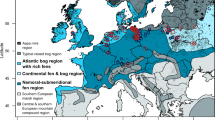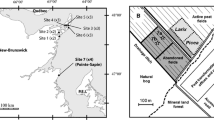Abstract
The restoration of ecosystem services, i.e., production, regulation, and information, is a global challenge, which the federal state of Mecklenburg-Vorpommern in NE Germany addressed in 2000 by rewetting over 20,000 ha of degraded peatlands within the Mire Restoration Program. We evaluated ecosystem services in 23 rewetted sites by assessing the following mire parameters within a ten year period: (a) dominant vegetation at the ecosystem level, (b) peat formation potential at the landscape level, and (c) aboveground biomass and nutrient levels. Seven to 10 years after rewetting, the wetlands formed a mosaic of vegetation types with the highest potential for peat formation and several dominant, peat-forming species accumulated high levels of aboveground biomass and nutrients (C, N, P). Common reed (Phragmites australis) accumulated the most biomass (up to 24 t dry matter/ha), and N+P during the growing season. A future management option is to annually harvest aquatic and wetland plants to reduce nutrient levels in restored mire ecosystems.







Similar content being viewed by others
References
Álvarez JA, Bécares E (2006) Seasonal decomposition of Typha latifolia in a free-water surface constructed wetland. Ecol Eng 28:99–105
Bakker JP, Berendse F (1999) Constraints in the restoration of ecological diversity in grassland and heathland communities. Trends Ecol Evol 14:63–68
Baratieri M, Patuzzi F, Thevs N, Zerbe S (2011) Assessment of suitable energy conversion scenarios of common reeds, Phragmites australis. In: Proceedings of the 19th European biomass conference and exhibition, Berlin. pp 1501–1514. doi:10.5071/19thEUBCE2011-VP2.3.38
Berg C, Dengler J, Abdank A, Isermann M (eds) (2004) Die Pflanzengesellschaften Mecklenburg-Vorpommerns und ihre Gefährdung. Weissdorn, Jena
Bernard JM, Hankinson G (1979) Seasonal changes in standing crop, primary production and nutrient levels in a Carex rostrata wetland. Oikos 32:328–336
Bernhardt ES, Palmer MA, Allan JD, Alexander G, Barnas K, Brooks S, Carr J, Clayton S, Dahm C, Follstad-Shah J, Galat D, Gloss S, Goodwin P, Hart D, Hassett B, Jenkinson R, Katz S, Kondolf GM, Lake PS, Lave R, Meyer JL, O’Donnell TK, Pagano L, Powell B, Sudduth E (2005) Synthesizing U.S. river restoration efforts. Science 308:636–637
Bonnett SAF, Ross S, Linstead C, Maltby E (2009) A review of techniques for monitoring the success of peatland restoration. University of Liverpool. Natural England Commissioned Reports 86, pp 189
Breiman L (2001) Random forests. Mach Learn 45(1):5–32
Clymo RS, Turunen J, Tolonen K (1998) Carbon accumulation in peatland. Oikos 81:368–388
Coops H, Boeters R, Smit H (2003) Direct and indirect effects of wave attack on helophytes. Aquat Botany 41:333–352
Dong Z, Chen G, He X, Han Z, Wang X (2004) Controlling blown sand along the highway crossing the Taklimakan desert. J Arid Environ 57:329–344
Edwards PJ, Abivardi C (1997) Ecological engineering and sustainable development. In: Urbanska KM, Webb NR, Edwards PJ (eds) Restoration ecology and sustainable development. Cambridge University Press, Cambridge, pp 325–352
Freund Y, Schapire RE (1996) Experiments with a new boosting algorithm. In: Machine learning: proceedings of the thirteenth international conference, 3–6 July 1996, Bari. pp. 148–156
Frick A, Steffenhagen P, Zerbe S, Timmermann T, Schulz K (2011) Monitoring of the vegetation composition in rewetted peatland with iterative decision tree classification of satellite imagery. Photogramm Fernerkund Geoinf 3:109–122
Granéli W (1984) Reed Phragmites australis (Cav.) Trin. ex Steudel as an energy source in Sweden. Biomass 4:183–208
Greenway M, Woolley A (2001) Changes in plant biomass and nutrient removal over 3 years in a constructed wetland in Cairns, Australia. Water Sci Techn 44:303–310
Gumbricht T (1993) Nutrient removal processes in freshwater submersed macrophytes systems. Ecol Eng 2:1–30
Hahn-Schöfl M, Zak D, Minke M, Gelbrecht J, Augustin J, Freibauer A (2011) Organic sediment formed during inundation of a degraded fen grassland emits large fluxes of CH4 and CO2. Biogeosciences 8:1539–1550
Hansson P, Fredriksson H (2004) Use of summer harvested common reed (Phragmites australis) as nutrient source for organic crop production in Sweden. Agric Ecosyst Environ 102:365–375
Hartmann M (1999) To the roots of peat formation: production and decomposition processes in a fen. Diss. Univ Greifswald, Greifswald
Hoagland CR, Lowell EG, David MB (2001) Plant nutrient uptake and biomass accumulation in a constructed wetland. J Freshw Ecol 16:527–540
Hobbs RJ, Arico S, Aronson J, Baron JS, Bridgewater P, Cramer VA, Epstein PR, Ewel JJ, Klink CA, Lugo AE, Norton D, Ojima D, Richardson D, Sanderson EW, Valladares F, Vilá M, Zamora R, Zobel M (2006) Emerging novel ecosystems: theoretical and management aspects of the new ecological world order. Glob Ecol Biogeogr 15:1–7
Holden J, Chapman PJ, Labadz JC (2004) Artificial drainage of peatlands: hydrological and hydrochemical process and wetland restoration. Prog Phys Geogr 28:95–123
Hölzel N, with contributions from Rebele F, Rosenthal G, Eichberg C (2009) Ökologische Grundlagen und limitierende Faktoren der Renaturierung. In: Zerbe S, Wiegleb G (eds) Renaturierung von Ökosystemen in Mitteleuropa. Springer, pp 23–53
Jansen F, Zerbe S, Succow M (2009) Changes in landscape naturalness derived from a historical land register: a case study from NE Germany. Landsc Ecol 24:185–198
Kätterer T, Andrén O (1999) Growth dynamics of reed canary grass (Phalaris arundinacea L.) and its allocation of biomass and nitrogen below ground in a field receiving daily irrigation and fertilisation. Nutr Cycl Agroecosyst 54:21–29
Ketcheson SJ, Price JS (2011) The impact of peatland restoration on the site hydrology of an abandoned block-cut bog. Wetlands: doi:10.1007/s13157-011-0241-0
Koska I (2001) Ökohydrologische Kennzeichnung von Moorstandorten. In: Succow M, Joosten H (eds) Landschaftsökologische Moorkunde. Schweizerbartsche Verlagsbuchhandlung, Stuttgart, pp 92–111
Kvĕt J, Husák Š (1978) Primary data on biomass and production estimates in typical stands of fishpond littoral plant communities. In: Dykyjová D, Kvĕt J (eds) Pond littoral ecosystems: structure and functioning. Springer, New York, pp 211–216
Maltby E (1997) Wetland soils: a perspective on scientific and management challenges. Seesoils J 12:4–12
Mitsch JW, Gosselink JG (1993) Wetlands, 2nd edn. Van Nostrand Reinhold, New York
MUNLV (Ministerium für Umwelt und Naturschutz, Landwirtschaft und VerbraucherschutzdesLandes Nordrhein-Westfalen) (2005) Erfolgskontrolle von Maßnahmen zur Unterhaltung und zum naturnahen Ausbau von Gewässern. Düsseldorf
Odonk JP, Kvĕt J (1978) Selection of sampling areas in assessment of production. In: Dykyjová D, Kvĕt J (eds) Pond littoral ecosystems: structure and functioning. Springer, New York, pp 163–174
Oswit J, Pacowski R, Zurek S (1976) Characteristics of more important peat species in Poland. In: Peatlands and their utilization in Poland, V. International Peat Congress Poznan. NOT, Warsaw, pp 51–60
Price JS, Rochefort L, Campeau S (2002) Use of shallow basins to restore cutover peatlands: hydrology. Rest Ecol 10:259–266
Price JS, Heathwaite AL, Baird AJ (2003) Hydrological processes in abandoned and restored peatlands: an overview of management approaches. Wetlands Ecol Manage 11:65–83
Quinlan JR (1993) C4.5: Programs for Machine Learning. Morgan Kaufmann Publishers, San Mateo
Rothmaler W, Jäger E, Werner K (eds) (2005) Exkursionsflora von Deutschland, Band 4. Gefäßpflanzen: Kritischer Band, 10th edn. Elsevier, München
Schulz K, Timmermann T, Steffenhagen P, Zerbe S, Succow M (2011) The effect of flooding on carbon and nutrient standing stocks of helophyte biomass in rewetted fens. Hydrobiologia. doi:10.1007/s10750-011-0782-5
Society for Ecological Restoration International (2004) The SER International Primer on Ecological Restoration. Version 2. http://www.ser.org/content/ecological_restoration_primer.asp
Steffenhagen P, Timmermann T, Schulz K, Zerbe S (2008) Biomasseproduktion sowie Kohlenstoff- und Nährstoffspeicherung durch Sumpfpflanzen (Helophyten) und Wasserpflanzen (Hydrophyten). In: Gelbrecht, Zak D, Augustin J (eds) Phosphor- und Kohlenstoff-Dynamik und Vegetationsentwicklung in wiedervernässten Mooren des Peenetals in Mecklenburg-Vorpommern—Status, Steuergrößen und Handlungsmöglichkeiten. Ber IGB 26:145–150
Steffenhagen P, Zerbe S, Frick A, Schulz K, Timmermann T (2010) Wiederherstellung von Ökosystemleistungen der Flusstalmoore in Mecklenburg-Vorpommern. Natursch Landschaftspl 42:304–311
Steffenhagen P, Zak D, Schulz K, Timmermann T, Zerbe S (2012) Biomass and nutrient stock of submersed and floating macrophytes in shallow lakes formed by rewetting of degraded fens. Hydrobiologia 692:99–109
Succow M, Joosten H (eds) (2001) Landschaftsökologische Moorkunde, 2nd edn. Schweizerbart, Stuttgart
Tanneberger F, Tegetmeyer C, Dylawerski M, Flade M, Joosten H (2009) Commercially cut reed as a new and sustainable habitat for the globally threatened Aquatic Warbler. Biodiv Conserv 18:1475–1489
Timmermann T, Margoczi K, Takács G, Vegelin K (2006) Restoration of peat-forming species-poor fen grasslands. Appl Veg Sci 9:241–250
Timmermann T, Joosten H, Succow M (2009) Restaurierung von Mooren. In: Zerbe S, Wiegleb G (eds) Renaturierung von Ökosystemen in Mitteleuropa. Springer, Stuttgart, pp 55–93
Van Andel J, Aronson J (2006) Restoration ecology: the new frontier. Wiely-Blackwell, Oxford
Van der Steen P, Brenner A, Oron G (1998) An integrated duckweed and algae pond system for nitrogen removal and renovation. Water Sci Tech 38:335–343
Verhoeven JTA, Van der Toorn J (1990) Marsh eutrophication and wastewater treatment. In Patten BC (ed) Wetlands and shallow continental water bodies. Case studies, vol. 1, SPB Academic Publishing, The Hague, pp 571–585
Westlake DF (1966) Biomass and productivity of Glyceria maxima—seasonal changes in biomass. J Ecol 54:745
Zak D, Gelbrecht J, Wagner C, Payer B, Augustin J (2010) Phosphorus mobilization in rewetted fens: the effect of altered peat properties and implications for their restoration. Ecol Appl 20:1336–1349
Zerbe S, Thevs N (2011) Restoring Central Asian floodplain ecosystems as natural capital and cultural heritage in a continental desert environment. In: Hong S-K, Wu J, Kim J-E, Nakagoshi N (eds) Landscape ecology in Asian cultures., Ecological Research MonographsSpringer, Dordrecht, pp 277–297
Zerbe S, Wiegleb G (eds) (2009) Renaturierung von Ökosystemen in Mitteleuropa. Springer, Stuttgart
Acknowledgments
This assessment of restoration success was based on single studies kindly supported by the Landesamt für Umwelt, Naturschutz und Geologie in Mecklenburg-Vorpommern (LUNG MV).
Author information
Authors and Affiliations
Corresponding author
Rights and permissions
About this article
Cite this article
Zerbe, S., Steffenhagen, P., Parakenings, K. et al. Ecosystem Service Restoration after 10 Years of Rewetting Peatlands in NE Germany. Environmental Management 51, 1194–1209 (2013). https://doi.org/10.1007/s00267-013-0048-2
Received:
Accepted:
Published:
Issue Date:
DOI: https://doi.org/10.1007/s00267-013-0048-2




